How are Nonunions and Osteomyelitis Treated?
How They are Treated
Treatment of nonunions requires different treatment methods, based on the problems facing each patient (infection, leg length discrepancy, limb deformity, etc.). A decision is made about the treatment method based on X-rays, as well as clinical and laboratory examinations.
A range of modern methods, such as “unilateral external fixators”, “The cable bone transport technique”, “internal osteosynthesis techniques such as those involving plates and intramedullary nails”, and the Taylor Spatial Frame (computer-assisted external fixator) are applied in the treatment.
Treatment of Nonunion of The Humerus (Pseudoarthrosis)
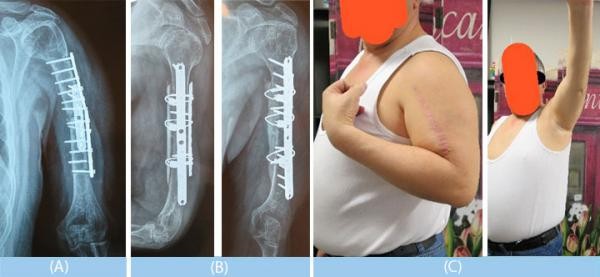
A) The humerus bone (upper arm) had been broken 4 years earlier (age 45) and bone union could not be achieved despite a number of surgeries being performed. As seen in the X-ray, the internal plates were broken and he was able to maintain his daily life without the use of his left arm.
B) He was treated with an internal osteosynthesis and bone graft technique.
C) 3 months after the nonunion surgery, the fracture was completely healed and he returned to daily life shortly after.
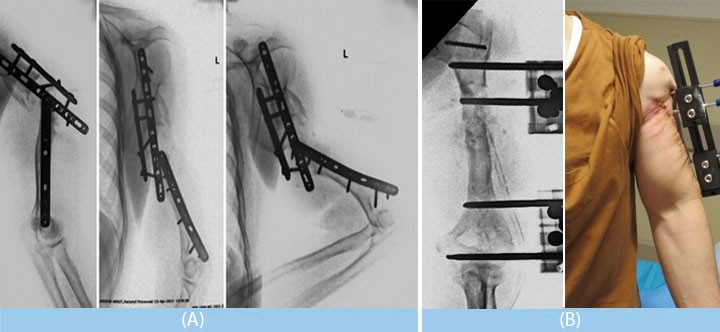
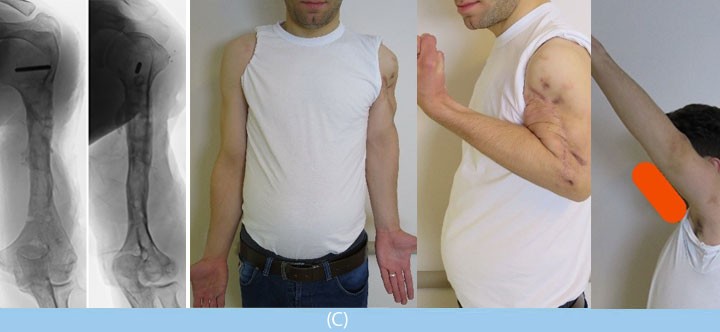
A) After an injury from 3 years earlier, a fracture occurred in the humerus (upper arm) (age 25). He had received 3 operations before, but all were unsuccessful. When he arrived, it was discovered that the plate and screws were broken. However, the arm did not seem to function in a completely unsteady manner.
B) During a 7-hour operation all the implants were removed and the patient was treated using the unilateral external fixator method. 5 months after the surgery the fracture had completely healed and the external fixator was removed. During this period, the patient was able to perform daily tasks such as eating with the external fixator.
C) At the end of the treatment, he achieved complete function of the arm without experiencing any effects from the previous problem.
Osteomyelitis Treatment
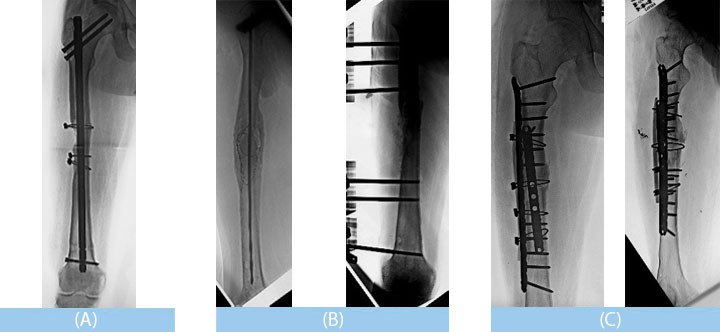
A) The femur was fractured 3 years before (age 30). After that, the intramedullary nail technique was used. After the operation, however, an infection developed, and in the end, bone inflammation (osteomyelitis) occured. Osteomyelitis presents a difficult situation, and according to old beliefs about the condition, it was said that could a treatment be found only in the death. However, osteomyelitis can be treated using modern medical treatment techniques.
B) The “Masquelet technique” was applied to the patient. This technique requires two or three stages of treatment. In the first stage, the osteomyelitis was cleaned, in the second stage a graft that was taken from the patient's own bone was applied, and in the third stage, the plate method (osteosynthesis) was used.
C) The treatment lasted a total of 5 months. At the end of treatment, the patient returned to daily life and sports.
Femur Nonunion Treatment
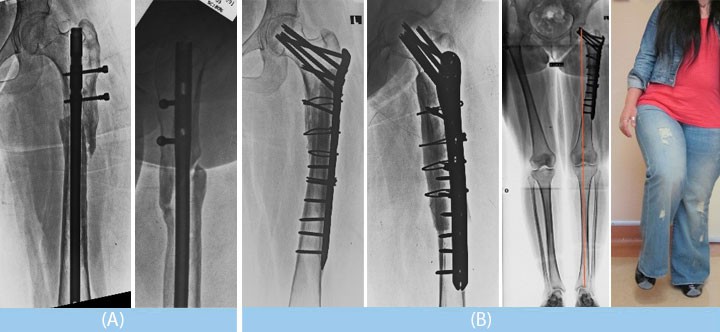
A) A fracture in the hip area of the femur occurred 6 years before following an accident (age 28). After that, surgery was done using the intramedullary nail technique, but the fracture did not heal. During the first operation, the locking screws of the intramedullary nails did not pass through the nail holes, which led to nonunion (pseudoarthrosis).
B) Surgery was performed using the "Sandwich technique", a special treatment method for pseudoarthrosis. In the 4th month following the treatment, the fracture was completely healed and the patient returned to daily life.
Tibia Nonunion Treatment
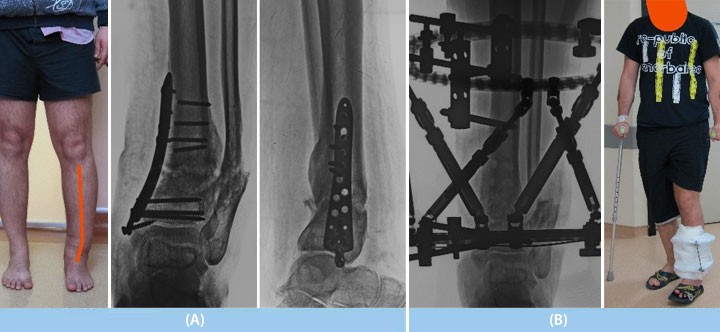
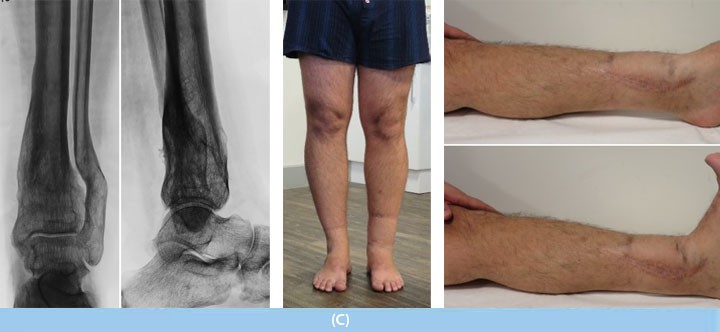
A) The tibia was broken (Pilon fracture) at the ankle after an accident from 2 years earlier. After that he received two operations (age 27). Because of improper treatment, nounion occurred and the plate and screws were broken.
B) The Taylor Spatial Frame (computer-assisted external fixator) technique was used. During the course of the treatment, starting from the next day after the surgery, he went from using elbow crutches to putting full weight on the leg without any support.
C) After five months of treatment, he returned to daily life and sports without losing any function.
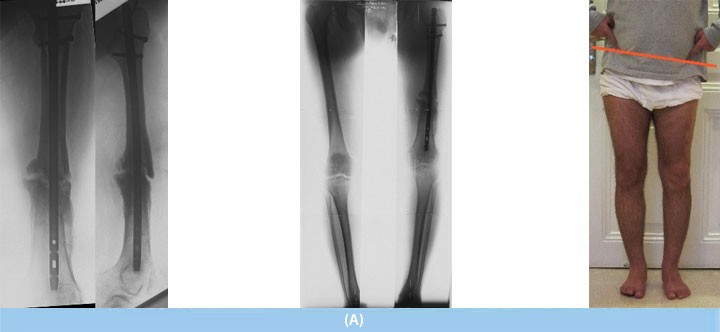
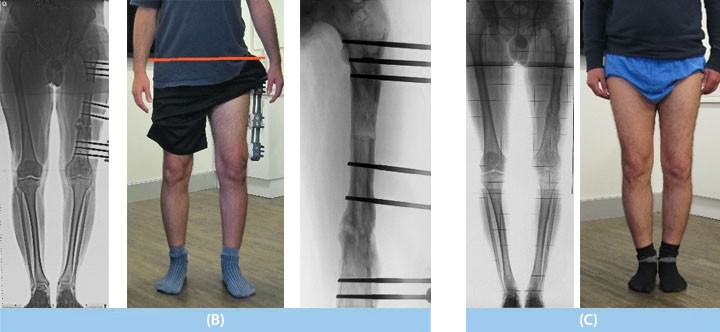
A) The femur was broken 2 years before following an accident (age 28) and was operated on. However, union was not achieved. Several attempts were made later to address the problem, but they were all unsuccessful. When he arrived, he had a 5cm discrepancy; however, he could walk with crutches and hadn't been able to work since the accident.
B) It was determined that the screws from the previous surgery had been applied incorrectly. The old implants were removed. Treatment was done using the unilateral external fixator technique. In the post-op period bone lengthening was done and the 5cm discrepancy was corrected.
C) At the end of treatment, he healed completely and returned to daily life and sports activities.
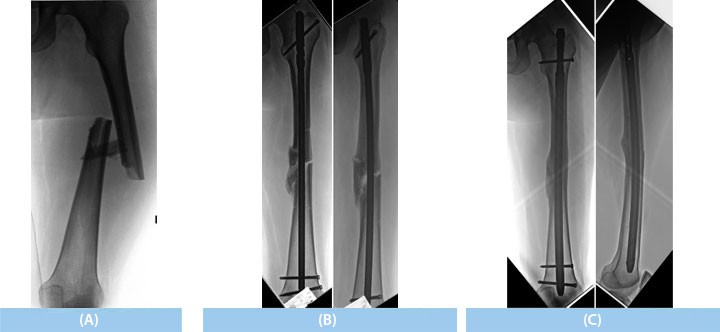
A) The femur was broken 3 years before following an accident and the patient was operated on using the intramedullary nail method (age 40) However, union was not achieved. When he arrived, he could walk with crutches but hadn't been able to work since the fracture occurred.
B) Surgery was performed using the "Exchange Nailing technique". The old implant was removed. A different intramedullary nail which was more suitable for this type of fracture was used.
C) The fracture had healed in the 3rd month following surgery and the patient returned to daily life and sports activities.
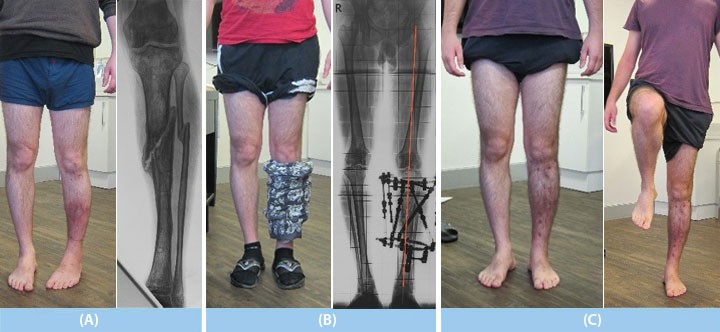
A) Talihsiz bir yaralanma ve tibia kırığı sonrasında başka bir hastanede eksternal fiksatör ile tedavi uygulanmış (28 yaşında). Ancak kırık kaynamamış, bacakta içe dönüklük, eğrilik ve akıntılı enfeksiyon vardı.
B) Taylor Spatial Frame (bilgisayar yardımlı akıllı fiksatör) ile tedavi uygulandı. Tedavi süresince ameliyatlı tarafına da tam basarak yürüdü.
C) Eğrilikler tam olarak düzeltildi ve kırığın kaynaması sağlandı. Altı aylık tedavi sonrasında tamamen normal günük hayatına ve spor aktivitelerine döndü.
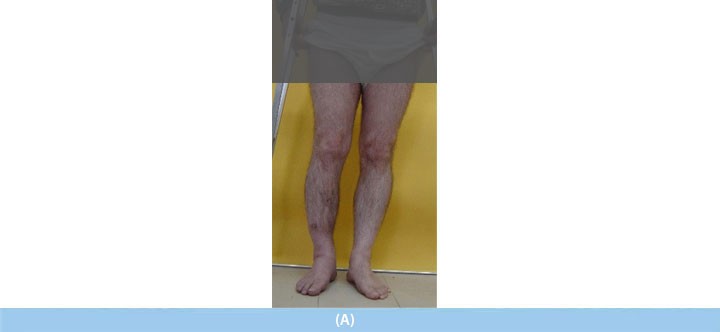
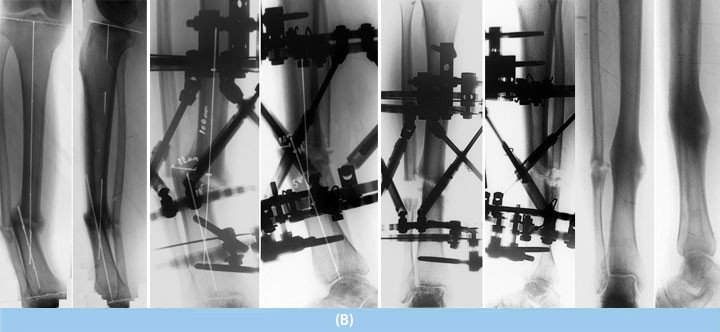
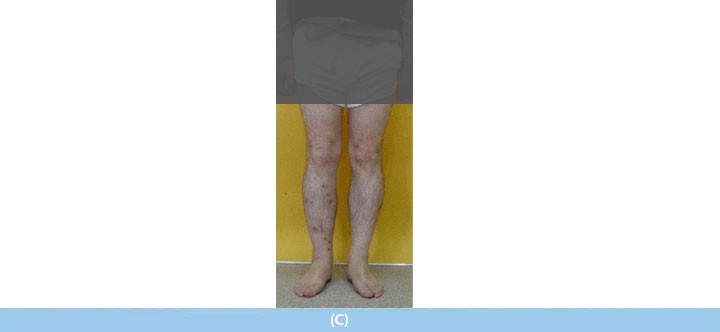
A) Following an unfortunate injury and tibia fracture, treatment at a different hospital was done using an external fixator (age 28). However, it resulted in a nonunion, an inward turning and curvature of the leg, and there was an infection.
B) The Taylor Spatial Frame (computer-assisted external fixator) was used in the treatment. During the treatment he walked fully on the operated leg.
C) The deformity was completely corrected and the fracture fused solidly. After 6 months of treatment, he returned to normal daily life and sports activities.
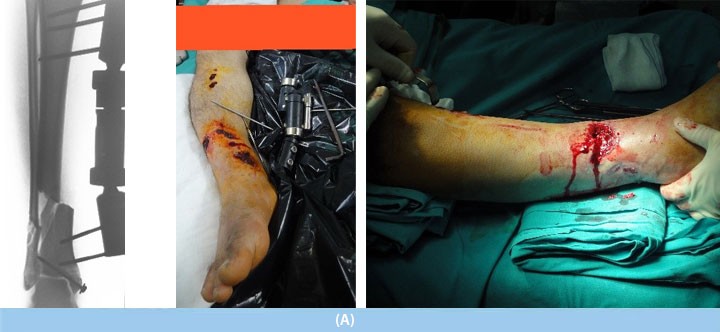
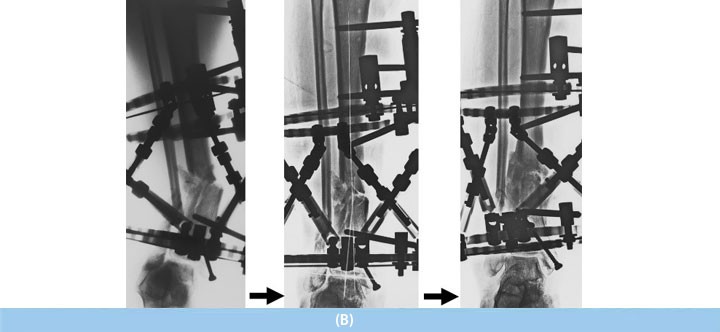
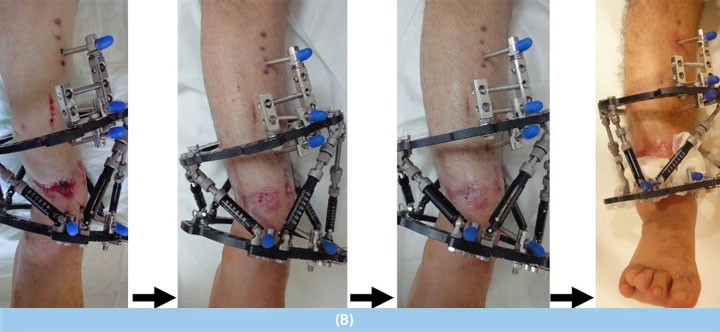
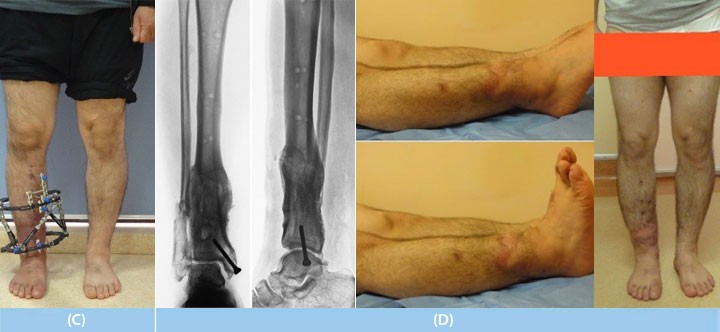
A) Following an open tibia fracture, surgeries were performed at a different medical center (age 48). However, there was not enough healing in the fracture, and there was deformity and discrepancy. However, he was able to walk with crutches.
B) The Taylor Spatial Frame (computer-assisted external fixator) method was applied in the treatment. X-rays were taken both before the treatment as well as during the correction & lengthening. During the treatment he walked fully on the operated leg. The deformity was completely corrected, bone lengthening was achieved and the fracture fused solidly.
C) After this stage, the patient was able to walk putting weight on the leg which was operated on. Thanks to the treatment that was applied, no additional plastic surgery was needed.
D) After 6 months of treatment, he returned to normal daily life and sports activities.
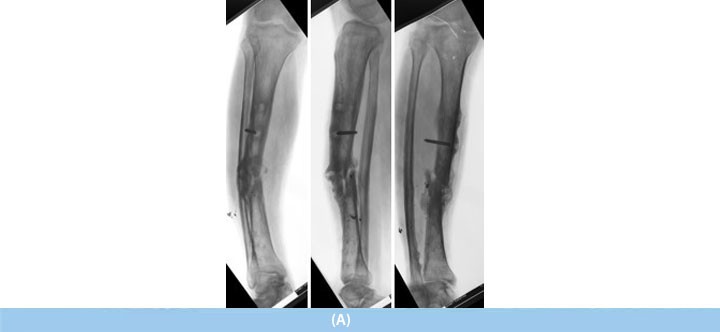
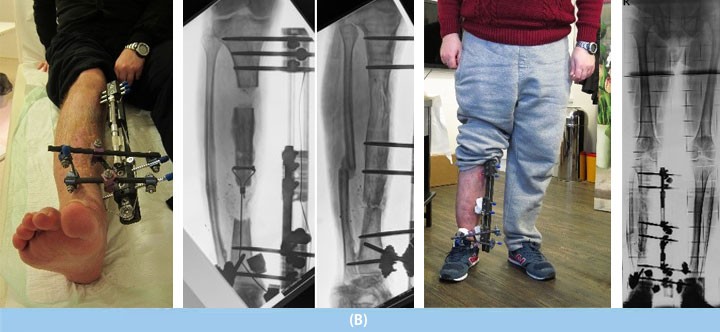
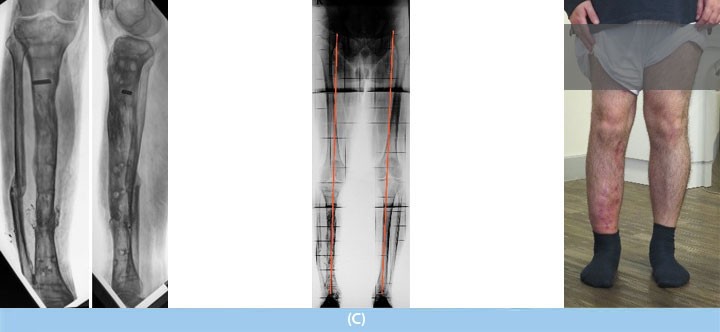
"Cable bone transport technique"
A) The patient underwent 3 operations following a gunshot injury from 2 years before (age 37). When he arrived, he could not put weight on the right leg and was experiencing pain; a pathological movement pattern was detected through manual examinaton. He had also been unable to work for 2 years.
B) The nonunion site was cleaned. Using the “Cable bone transport technique”, the bone was repositioned during surgery. (The New Intramedullary Cable Bone Transport Technique, Metin Kucukkaya, et al., J Orthop Trauma 2009). This technique is particularly effective in the treatment of large bone defects. The necessary amount of bone lengthening was applied to ensure that the discrepancy did not remain. During the treatment, the patient was walking on crutches with the external fixator in place, and was also able to perform daily tasks.
C) After the treatment, the fracture healed completely and the patient returned to normal daily life and sports activities without any discrepancy reoccurring. A view of the mechanical axis in the graph shows completely normal alignment on the side that was operated on.
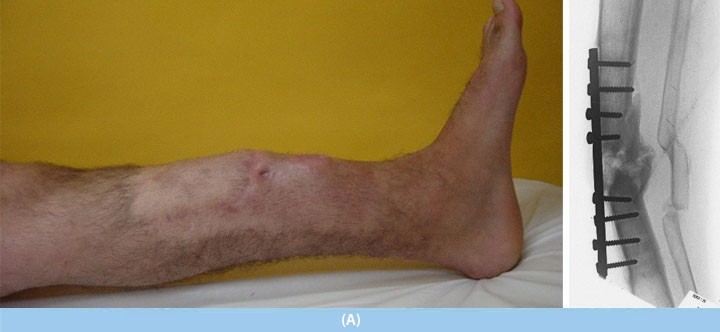
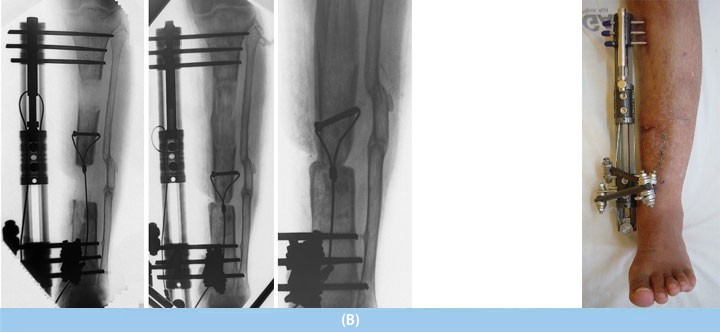
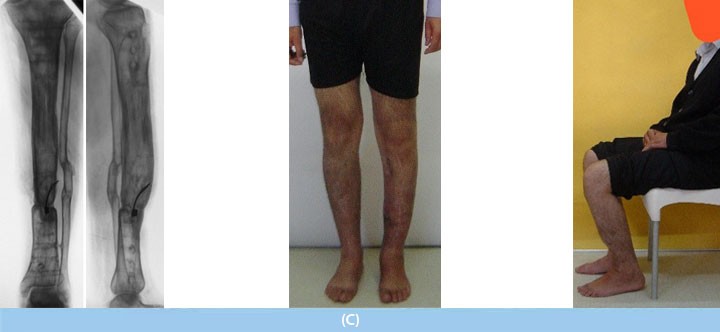
"Cable bone transport technique"
A) The tibia was broken 3 years before following an accident and a number of surgeries were performed (age 28). In the area of the fracture, infection and nonunion developed. When he arrived, he had a wound with discharge and bad odor and wasn't able to put weight on the leg. Also, he had been unable to work for 3 years.
B) The infected area was cleaned, the plate and screws were removed, and using the “Cable bone transport technique”, the bone was repositioned during surgery. (The New Intramedullary Cable Bone Transport Technique, Metin Kucukkaya, et al., J Orthop Trauma 2009). This technique is particularly effective in the treatment of large bone defects.
C) After the surgery, the fracture was completely healed and the patient returned to normal daily life.
Leg Length Discrepancy
and Limb Deformities
in Children
Leg Length Discrepancy
and Limb Deformities
in Adults?
Nonunions
and
Osteomyelitis
Achondroplasia
(Nanism)
Cosmetic
Leg Lengthening
How are length
discrepancies in the
toes and arms treated?
Length Extension
Techniques
- Lengthening Nails
- External Fixators
- Combined techniques
